[vc_row][vc_column][/vc_column][/vc_row][vc_row][vc_column][vc_tta_accordion c_icon=”chevron” active_section=”100″ collapsible_all=”true”][vc_tta_section title=”Mowing” tab_id=”1457711416374-11f8328d-1eae”][vc_row_inner][vc_column_inner][vc_column_text]
Mowing of is utmost important in maintaining a lustrous healthy lawn. One of the largest mistakes made by most homeowners is cutting the lawn way too short. Many people feel that cutting the lawn shorter buys them more time before cutting again or that is provides a tighter look within the lawn.
Well, the correction to this is that no matter how short you mow the lawn, you still mow the same no matter how short tall you choose to mow. So with this said, mowing the lawn shorter not only stunts and discolors the lawn, but also causes a lot of stress to the lawn making it less tolerable to drought, disease, and of course lessens its ability to fight weed infestations.
One of the best and most effective methods of weed control is by managing a proper mowing height. By mowing at the desired heights, the lawn flourishes growing denser and thicker eliminating the needed space light for weeds to develop.
Before you ever decide to utilize a weed control program, first do yourself a favor and adjust your mowing height to the proper standards. The rule of thumb is to never mow more than 1/3 of the growth height back. For Fescues, being the most common grass in our area, the proper height in spring and fall is 2.5″ – 3″ and in the summer months 3″-3.5″. You may have a hard time adjusting to these heights, but trust us and try it for a while and you’ll see many areas of improvement especially in the enhanced coloring of the lawn.
The next and as important to element to mowing is maintain a sharp mower blade. For residents, you should have your mower blade sharpened at least 1-2 times each year, and having your mower blades sharpened once each mowing season is even better. When cutting the lawn with dull blades, the cut end of the grass blade becomes very shredded instead of a clean sharp cut. This frayed grass blade provides a brownish hue to the lawn as well as can cause various disease problems within the lawn.
[/vc_column_text][/vc_column_inner][/vc_row_inner][/vc_tta_section][vc_tta_section title=”Fertilizing” tab_id=”1457711793380-1576470d-b9bb”][vc_row_inner][vc_column_inner][vc_column_text]
Fertilizing your lawn is critical in managing not only the color and consistent growth, but also the overall health of the lawn and it’s ability to resist and fight disease, weeds, as well as heat and cold stress.
There is vast amounts of opinions about fertilizer types and uses, so I’ll keep my suggestions brief and general. Along with three major categories of macro nutrients, being nitrogen, phosphorous, and potassium, another important area of nutrients to remember are the micro nutrients. Most high quality fertilizers will contain a range of both macro and micro nutrients.
You’ll probably start noticing that most professional lawn fertilizers now do not have phosphorous present due to recognized danger of this nutrient when transported into streams and bodies of water by runoff.
When utilizing a quality lawn fertilizer, looker for slower releasing nitrogen containing either urea forms of nitrogen or other forms of sulfur coated or slow release nitrogen coatings. These will 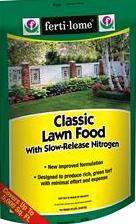 provide you with a more consistent release of the nitrogen ensure a more controlled growth pattern.
provide you with a more consistent release of the nitrogen ensure a more controlled growth pattern.
When applying granular fertilizers, be sure to be aware of the broadcast or drop spreader settings. When in doubt, set the setting at a lower rate until you are comfortable of the proper setting. All granular lawn fertilizers are sold in bags listing the square footage coverage area. Be sure to measure out your target lawn area and purchase the accurate amount of fertilizer. Do not over apply fertilizers and do not apply granular lawn fertilizers by hand or with spreaders that do not have a calibrated method of application.
Evergreen of Johnson City has always recommended Fertilome fertilizers. We carry several selections of lawn fertilizers including those containing various supplemental weed control herbicides. Let us help you customize a lawn fertilizer program for your lawn.
[/vc_column_text][/vc_column_inner][/vc_row_inner][/vc_tta_section][vc_tta_section title=”Weed Control” tab_id=”1457711470482-79029230-b432″][vc_row_inner][vc_column_inner][vc_column_text]
Weed control n lawns in usually required to some level, but remember to utilize proper mowing techniques to manipulate your lawn’s natural defenses against weeds. There are two primary categories of herbicides used to fight both broadleaf and grassy weeds. Pre Emergent herbicides used to prevent weed seeds from germinating and post emergent herbicides to selectively kill out weeds once they are growing and established.
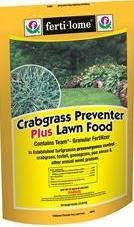 Pre-emergent herbicides, such as Fertilome Crabgrass Preventer Plus Lawn Food, are most commonly available in granular forms and applied in early spring as one of the primary ways to keep crabgrass and other weed grasses from germinating. Crabgrass, being an annual weed, only comes back from seed and the use of a pre-emergent herbicide is the main way from keeping the majority from coming back. Depending on the type of pre-emergent used, main grassy weeds and selective broadleaf weeds are preventing from germinating in early spring. One such type, Fertilome All Season Crabgrass Preventer Plus Lawn Food, includes a pre-emergent herbicide to apply in the fall mainly focused towards the prevention of broadleaf weed germination during the cool season.
Pre-emergent herbicides, such as Fertilome Crabgrass Preventer Plus Lawn Food, are most commonly available in granular forms and applied in early spring as one of the primary ways to keep crabgrass and other weed grasses from germinating. Crabgrass, being an annual weed, only comes back from seed and the use of a pre-emergent herbicide is the main way from keeping the majority from coming back. Depending on the type of pre-emergent used, main grassy weeds and selective broadleaf weeds are preventing from germinating in early spring. One such type, Fertilome All Season Crabgrass Preventer Plus Lawn Food, includes a pre-emergent herbicide to apply in the fall mainly focused towards the prevention of broadleaf weed germination during the cool season.
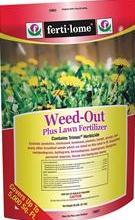 Post emergent herbicides are either applied in granular or liquid forms. Most common are granular forms found incorporated into lawn fertilizers, such as “Fertilome Weed Out”, and are applied as part of a fertilizer application. Be sure to ask the professionals at Evergreen about the proper methods of applying such granular broadleaf herbicides. You can also click on the product name in blue to see more details and instructions on each of the products listed.
Post emergent herbicides are either applied in granular or liquid forms. Most common are granular forms found incorporated into lawn fertilizers, such as “Fertilome Weed Out”, and are applied as part of a fertilizer application. Be sure to ask the professionals at Evergreen about the proper methods of applying such granular broadleaf herbicides. You can also click on the product name in blue to see more details and instructions on each of the products listed.
Also available are post emergent herbicides in liquid applications that are usually applied separately from fertilizers. Though liquid post emergent herbicides are more difficult to apply, you’ll always receive much better results with a single application. We suggest using our favorite being Fertilome Weed Out that is effective to use during the growing season on either a broad coverage application or you can simply keep a small tank sprayer on hand for spot spraying various broadleaf weeds as needed.
[/vc_column_text][/vc_column_inner][/vc_row_inner][/vc_tta_section][vc_tta_section title=”Disease Control” tab_id=”1457711603231-762cf747-d237″][vc_row_inner][vc_column_inner][vc_column_text]
Though disease control isn’t talked about as much as other forms of lawn care needs. With the 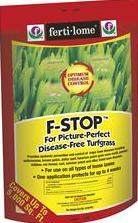 heavy rainfalls that have occurred over the recent years, lawn diseases have been more prevalent than ever. One of the things to remember is that early detection and prevention is the best weapon against controlling and ridding the lawn of diseases.
heavy rainfalls that have occurred over the recent years, lawn diseases have been more prevalent than ever. One of the things to remember is that early detection and prevention is the best weapon against controlling and ridding the lawn of diseases.
Be sure to determine which form of disease you may be dealing with. Some diseases, such as Brown Patch, thrive within lawns with high nitrogen levels meaning those being fertilized heavily. Sometimes common sense techniques, such as cutting back on fertilizers during early detection of Brown Patch, is needed to limit its activity. Other diseases are common in poorly fertilized lawns. Keeping lawns cut properly is also an important factor and remember to keep those mower blades sharp.
Lawn fungicides can be purchased and applied in both liquid and granular forms. We are recommending the use of either
- Fertilome Systemic Fungicide a liquid fungicide, or
- Fertilome F-Stop Fungicide, which is a granular fungicide promoting ease of application.
[/vc_column_text][/vc_column_inner][/vc_row_inner][/vc_tta_section][vc_tta_section title=”Aeration & Dethatching” tab_id=”1459363271277-1944a24a-af23″][vc_row_inner][vc_column_inner][vc_column_text]
Aeration, or core cultivation, is standard lawn care. Aerating a lawn means supplying the soil with air, usually by poking holes in the ground throughout the lawn using an aerator. It reduces soil compaction and helps control thatch in lawns while helping water and fertilizer move into the root zone.
A lawn can be aerated at any time the ground is not frozen, but should not be done when it is extremely hot and dry. Heavy traffic areas will require aeration more frequently.
Aeration is most effective when actual cores or plugs of soil are pulled from the lawn. Holes should be two to three inches deep and no more than two to four inches apart. Lawns should be thoroughly watered the day before aerating so plugs can be pulled more deeply and easily. Mark all sprinkler heads, shallow irrigation lines and cable TV lines before aerating so those lines will not be damaged.
On thatchy lawns, it is important to leave the cores on the lawn, allowing them to work back into the grass. Otherwise, the cores may be removed or left on the lawn. Lawns may be fertilized and seeded immediately after aeration. There is no need to top dress lawns following aeration.
Though thatch build isn’t common with Fescue types, it can occur and is very prevalent in Bluegrass grass types. Dethatching is usually only performed every several years at the most, where some lawn rarely or ever require to be mechanically performed. As mentioned above, yearly core plugs derived from Aerating procedures will bring natural bacteria to the lawn’s surface aiding in the natural decaying and breakdown of grass thatch.
[/vc_column_text][/vc_column_inner][/vc_row_inner][/vc_tta_section][vc_tta_section title=”Watering Your Lawn” tab_id=”1459363314783-d1f6cd5c-5429″][vc_row_inner][vc_column_inner][vc_column_text]
It’s simply amazing how a mid-summer drought can burn out a lawn, turning it brown and dry. More amazing still, is how the return of rain and cooler temperatures will bring back that lush, green growth. In most cases, lawns will come back with little or no long-term damage. Nature certainly built toughness into most grasses.
Many of us want lush, green lawns all year. So, watering is an important part of a healthy, green lawn. Here are some tips and ideas for proper watering to assure maximum benefit to your lawn.
People will water their lawns day or night, whenever it is convenient. Some people (and many businesses, apartments, and golf courses) employ automatic sprinklers, and water in the middle of the night or in the wee hours of the morning before dawn when people are not out and about.
The choice of timing is generally a matter of convenience – when are you home to water your lawn? Regardless of the answer, it is important to know the advantages and disadvantages of day versus nighttime watering.
Daybreak or just before dawn is the ideal time to water your lawn. Evaporation is at a minimum, and the rising sun will quickly dry the grass, reducing the likelihood of disease. Unfortunately, many of us have a day job to go to, and find it difficult at best, to go out in morning before work to get the hoses and sprinklers working.
Daytime– Daytime is also a good time to water your lawn. You can pour on generous amounts and allow it to soak in. The blades of grass dry quickly, minimizing the risk of plant disease. The major disadvantage is it takes more water. Evaporation steals a portion of the water you apply, before it can soak in and reach the grass roots.
Nighttime– A lot of us choose nighttime and the hours just before dark for two reasons. First, is the simple fact that we are home. After dinner is the time many of us devote to caring for our lawns and yards. We also know that the water we apply will not be robbed by the sun through evaporation. The major disadvantage is plant disease thrives in wet, humid conditions. The water sits on the blades of grass all night, improving the breeding ground for disease.
Did you know? One of the best times to water your lawn is when it is raining. Often, summer rains are too light to add any real benefit. Supplementing the rainfall with your sprinkler gets the water down to a sufficient depth to water all of the roots. Remember, we are talking about light summer rains, not thunder storms or heavy downpours. Give it some thought….give it a try.
How much and How often?
General wisdom is to water your lawn deeply once or twice a week. Apply one to one and a half inches or water each time. Light, daily watering leaves too much water at or near the surface of the soil, and does not reach all of the roots where it is needed.
Deep watering allows moisture to reach the deepest roots. Allowing the soil to dry between watering will encourage the roots to go deeper to reach the moisture and nutrients it needs.
Daily, light watering will cause the roots of your grass to become dependent upon you to provide the water that it needs. So, train your lawn, before it trains you!
[/vc_column_text][/vc_column_inner][/vc_row_inner][/vc_tta_section][vc_tta_section title=”Hybrid Fescues & Their Benefits” tab_id=”1459363439817-aaaf7c96-e8ae”][vc_row_inner][vc_column_inner][vc_column_text]
Fescues are the areas most popular and successful turf grass types. East Tennessee located in what’s known as the Transition Zone meaning that we fall in-between the northern and southern lawn zones.
Tall Fescues are the most popular types of fescues for our area for partial to full sun areas. Fines fescues are also becoming more commonly known for their acceptability in low light shady lawn conditions. A common and increasingly popular category of fescues are the hybrid fescues which are not marketed in a wide range of brands and mixes.
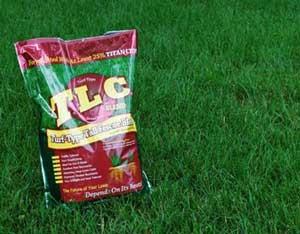 Hybrid fescues, such as the well known TLC Hybrid Fine Fescue line, are hybrid strains of the tall fescue line that have been hybridized to provide quality features such as darker green color, narrower blade size, softer and finer texture, and enhanced ability to spread by root tillering where common fescues have a clumping action. This spreading feature provides hybrid fescues to recover easier from stress such as traffic, drought, cold, disease, and weed infestation.
Hybrid fescues, such as the well known TLC Hybrid Fine Fescue line, are hybrid strains of the tall fescue line that have been hybridized to provide quality features such as darker green color, narrower blade size, softer and finer texture, and enhanced ability to spread by root tillering where common fescues have a clumping action. This spreading feature provides hybrid fescues to recover easier from stress such as traffic, drought, cold, disease, and weed infestation.
Evergreen of Johnson rarely suggest any seed blend other than hybrid fescue blends such as our popular TLC Hybrid Fescue Grass Seed. This mix utilizes a mix of several Rebel hybrid fescues to utilize a blend of variety benefits to ensure a successful blend for those lawns with varying soil and light conditions.
The recommended seeding rate for most hybrid fescues is 7 -8 lbs. per 1,000 sq.ft. for seeding new lawns and 3-4 lbs. per 1,000 sq.ft. for over-seeding techniques.
[/vc_column_text][/vc_column_inner][/vc_row_inner][/vc_tta_section][vc_tta_section title=”Natural Guard Soil Activator” tab_id=”1459363536566-72a3bfec-abf6″][vc_row_inner][vc_column_inner][vc_column_text]
Natural Guard Soil Activator with 100% Humates
GENERAL BENEFITS OF HUMATES:
Humate is a natural product and has no chemical additives.
Humate is an organic compost containing a high concentration of humic acid which is recycled back into the soil.
Humate holds nutrients in a usable form and releases them to the growing plant as needed. It stretches out the food availability between feedings.
Humate helps aerate the soil. It assists in preventing formation of large lumps and stratification of the soil.
Humate activates the decomposition of plowed under crop remains, new compost and grass clippings.
Humate increases the water-holding capacity of soils. Soil containing humate resists drought more effectively and produces better yields where rainfall or irrigation may otherwise be insufficient. (Yields increase up to 1000% in sandy loam soils and 700% in clay soils.)
Humate is a supplement to crop rotation, green manures, animal manures and inoculation of the soil with micro-organisms such as those found in Natural Guard’s Natural Granular Fertilizer (9-4-4).
Humate improves the workability of the soil. Heavy clay soils can be worked into satisfactory seed beds and marginal soils into profitable soils. Soils are more crumbly and suitably-sized particles are formed in the aggregate.
Humate reduces soil erosion by increasing the cohesive forces of very fine soil particle and promotes desirable drainage and water intake.
BENEFITS OF HUMATES ON YOUR LAWN:
Promotes decomposition of grass clippings and thatch, turning them into valuable soil nutrients
Improves soil structure (tight soils will become crumblier, sandy soils show improved moisture retention)
Improves soil life (better residue breakdown and more beneficial earthworm activity)
Increases availability of soil nutrients, improving plant nutrition
Enhances seed germination, emergence and survival
Improves root development
Improves plant vigor and appearance (visual quality)
Little or no increased frequency of mowing
Makes your plants less susceptible to stress
In addition to humates, Soil Activator contains 17 other trace elements for the health of your lawn. It is a ‘must’ product for anyone with a mulching blade mower. Use Natural Guard Soil Activator twice a year, once with the first spring feeding and again in the fall – at a rate of one bag per 2,000 sq. ft.
[/vc_column_text][/vc_column_inner][/vc_row_inner][/vc_tta_section][vc_tta_section title=”Grub Control” tab_id=”1459363637181-f65431d1-2c52″][vc_row_inner][vc_column_inner][vc_column_text]
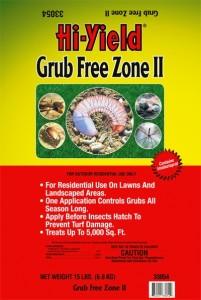 Grubs and their damages to your lawn can be easily missed and incorrectly diagnosed. Grubs damage the lawn during two heavy feeding cycles caused by two generations of this pests. The first generation is in early spring when the larvae “grubs” come from deep below the grass root zone and shallow feeding on grass roots to eventually emerge from the lawn into the adult beetle form. The second generation controlled by this single application is when the beetles lays eggs back into the lawn in late June to early July developing into the next generation of grubs which, for a period of time, feed on the lawn’s tender roots and eventually migrate deeper into the soil area to continue their damage the next spring season.
Grubs and their damages to your lawn can be easily missed and incorrectly diagnosed. Grubs damage the lawn during two heavy feeding cycles caused by two generations of this pests. The first generation is in early spring when the larvae “grubs” come from deep below the grass root zone and shallow feeding on grass roots to eventually emerge from the lawn into the adult beetle form. The second generation controlled by this single application is when the beetles lays eggs back into the lawn in late June to early July developing into the next generation of grubs which, for a period of time, feed on the lawn’s tender roots and eventually migrate deeper into the soil area to continue their damage the next spring season.
Evergreen promotes the use of several products all designed to kill the beetle grubs in the larvae state of their development which resembles a whitish grub such as the picture shown in this article. One of our most popular selections suggested is our HiYiled Grub Free Zone II specially formulated to control grubs all season long with only a single application.
Remember, late diagnosis of grub damages is usually too late. It’s best to treat the larvae “grubs” during their younger or smaller size and before they manage to eat and damage too much tender lawn roots. The effects of grub damages in your lawn will be browning patches that will become evident during late spring and early summer when drier lawn conditions require more water uptake by the roots that have been damaged by grub feeding.
[/vc_column_text][/vc_column_inner][/vc_row_inner][/vc_tta_section][vc_tta_section title=”Brown Patch Disease in Lawns” tab_id=”1459363707231-c0228ccd-4365″][vc_row_inner][vc_column_inner][vc_column_text]
Brown Patch, Rhizoctonia solani, is a common lawn disease that is prevalent in lawn being managed to good standards. Unlike most lawn diseases, brown patch exists in conditions where high nitrogen levels are present, so lawns being fertilized regularly are prone to brown patch when other environmental conditions are also present.
Along with elevated nitrogen levels, high temperatures, high humidy, and high moisture levels are trigger points for brown patch infestations in fescue and blue grass lawns in our region. Though, fungicide treatments are available, the higher cost of these applications lead to preventative treatment as the first option when available. Below are typical treatments to include both preventative measures through proactive lawn management tactics as well as preventative and curative treatments utilizing liquid and granular fungicides.
Decrease nitrogen levels meaning to decrease fertilizer applications
Maintain sharp mower blades – diseases spread more rapidly on frayed grass
Decrease irrigation system intervals especially during rainy weather periods
Eliminate irrigating at late evening or nighttimes.
Pick up or prevent excessive clippings on lawn
Shorten mower heights to 2.5″ – 3″ to improve air flower and drying habits.
Apply fungicides by utilizing either granular fungicides or liquid fungicides
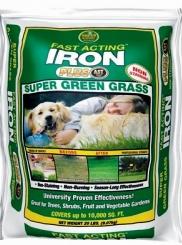 Though fungicides are many times needed, utilize this as a last resort to treatment. When choosing to decrease fertilizer applications, consider apply Encap Fast Acting Iron to lawns as a method of greening without the use of nitrogen.
Though fungicides are many times needed, utilize this as a last resort to treatment. When choosing to decrease fertilizer applications, consider apply Encap Fast Acting Iron to lawns as a method of greening without the use of nitrogen.
Evergreen of Johnson City also offers two forms of fungicides that can be used for direct preventative or curative control of brown patch and other lawn diseases. Fertilome F-Stop Fungicide Granules including fungicide is an easy
fungicide is an easy
effective granular that is simple to 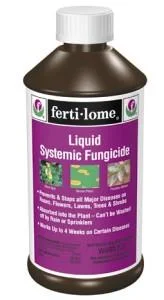 apply with a lawn spreader.
apply with a lawn spreader.
Also supplied by Evergreen of Johnson City is Fertilome Systemic fungicide is a systemic action liquid fungicide that is wonderful for controlling a wide range of lawn diseases including brown patch.
Below are website links that will allow you to review more information on Brown Patch, it’s symptoms, favorable conditions, and control.
UK Extension – Brown Patch Disease
Grounds Maintenance – Managing Brown Patch in Tall Fescue
[/vc_column_text][/vc_column_inner][/vc_row_inner][/vc_tta_section][vc_tta_section title=”Taking Lawn Soil Samples for Testing” tab_id=”1459364055999-df8e3ed5-5baa”][vc_row_inner][vc_column_inner][vc_column_text]
Testing of your lawn’s soil will provide you an understanding of the nutrients and soil supplements needed to ensure a lush and healthy lawn environment. Soil sample testing kits of various types can be acquired at Evergreen of JC to test either your lawn’s pH levels only or for a total view of pH, Phosphorous, & Potassium levels.
When testing samples of your lawn’s soil, each soil sample should contain soil from several different places and total up to 1 pint. Separate soil samples are only needed when site conditions are quite different. Examples of varying sites would be deep shade vs. full sun, or clay soil content vs. brown earthy topsoil.
Always use generally clean tools to take lawn samples with and always discard the top couple inches of surface soil acquiring a medium of soil in the 2-4″ depth range. For pH only, direct stick testing digital meters are available for quick readings but liquid tests are required for a test of wider ranges.
[/vc_column_text][/vc_column_inner][/vc_row_inner][/vc_tta_section][/vc_tta_accordion][/vc_column][/vc_row]